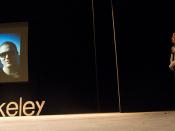"There are dualities within each duality," (Shlain, pg. 431). Perhaps this quote is true in that most everything in this world has a polar opposite. Many contrary terms are easy to recognize and usually have a simple effect on life such as off and on, stop and go, light and dark. However, there exist dualities in which the effects are more difficult to recognize. In reading chapter 35 of The Alphabet and the Goddess, it is shown that the patterns of the literary word versus the image have had profound effects on people from around the world.
Throughout this chapter, Dr. Shlain's main point is this: The European alphabet has led to extreme logical thinking amongst the people who use it, therefore diminishing most emotion-based thinking on important life decisions. According to Shlain, the left hemisphere of the human brain is responsible for the logical, strategic, "hunter/killer" thinking, whereas the right hemisphere is in charge of the intuitive, emotional, "gatherer/nurturer" thoughts.
"Task-oriented beta waves activate the hunter/killer side of the brain as alpha and theta waves emanate more from the gatherer/nurturer side," (Shlain, pg. 408). Therefore, the European alphabet, in its logical format and reason, has overpowered the beta waves in the brain so that much of the thinking amongst people has been for strategic, survival reasons.
Shlain argues that extreme logical thinking may have been at the core of many of the territorial disputes between different cultures. He provides evidence that some societies (such as the Chinese, whose own alphabet consists of imagery versus literary terms) had lived in harmony until the linear word invaded their culture. If it weren't for the invention of the television, helping to balance logic left-brained thinking with the iconic right brain, the world may have been ultimately destroyed. "For all their virtues, abstract science, linear words, and sequential equations had led the world to the brink of extinction," (Shlain, pg.409).
Though this chapter illustrated some significant points concerning how people react to the literary word, some people may find this argument to be controversial. Throughout the reading, Shlain consistently compares the right brain as being associated with feminine qualities, and the left brain as being connected to masculine attributes. This may be found to offend some women in that they are being referred to as intuitive and imaginative. That is to say, women are not being connected with logic or reason- a point that Shlain mentions may be a reason why females are struggling today for equal rights. However, there have been several women who have been recorded in history for their logical thinking. Some examples include Mary Tudor, who was the first woman to take the throne as Queen; Harriet Tubman, who led over 300 fugitive black slaves to freedom; and Maya Angelou, who used the literary alphabet to write several novels that are currently being read today. Ultimately, if people tend to take Shlain's perceptions concerning men and women offensively, then one should more critically assess his credibility in making such arguments.
Dualities exist throughout the world, and each one aids in shaping our perspectives of life. In analyzing the environment in which we live, it is important to consider both sides of the spectrum. Both the written word and the icon need to be brought together in equilibrium in order to make a balanced decision. As Shlain wrote on page 431, "Emphasis on one hemispheric mode at the expense of the other is noxious. The human community should strive for a state of complementarity and harmony."


